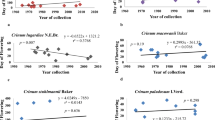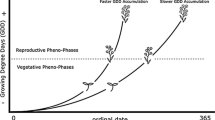Abstract
Several pieces of evidence indicate that global climate change is affecting biological systems all across the world. Phenology is one of the tools that may indicate changing patterns. The paper focuses on the phenological pattern of alpine/sub-alpine species Aconitum heterophyllum, a high-value medicinal herb of the Indian Himalayan Region (IHR), a global hotspot and known to be sensitive to climatic change. In all 117 herbarium specimens of the species collected from three provinces (Western Himalaya, North West Himalaya and Trans Himalaya) of the region were recorded. Historic herbarium records (1848–2003) were analyzed to predict the flowering patterns using Generalized Additive Model (GAM) in view of complexity in the herbarium-based data structure. GAM indicated that the flowering time responded significantly, 26 days earlier per 1,000 m (P < 0.02). Likewise, the model showed significantly earlier flowering (17–25 days) during the last 100 years (P < 0.01). Moreover, maximum temperature of winter (December–February) explained increasing trends at both elevations (lower and mid) and mean winter temperature influenced the early flowering time (19–27 days) with an increase of 1°C. The overall early flowering of A. heterophyllum may perhaps be considered as indicator of climate change; however, more datasets of herbarium records are required to further strengthen this premise. This study was undertaken to show that herbarium records could be utilized as a potential resource for assessing climate change using GAM.




Similar content being viewed by others
References
Abu-Asab MS, Peterson PM, Shetler SG, Orli SS (2001) Earlier plant flowering in spring as a response to global warming in the Washington, DC, area. Biodivers Conserv 10(4):597–612
Bolmgren K, Lõnnberg K (2005) Herbarium data reveal an association between fleshy fruit type and earlier flowering time. Int J Plant Sci 166(4):663–670
Bowers JE (2007) Has climatic warming altered spring flowering date of Sonoran desert shrubs? Southwest Nat 52(3):347–355
Bradshaw WE, Holzapfel CM (2001) Genetic shift in photoperiodic response correlated with global warming. Proc Natl Acad Sci USA 98:14509–14511
Chopra RN, Nayar SL, Chopra IC (1986) Glossary of Indian medicinal plants (including the supplement). CSIR, New Delhi
Dhar U, Rawal RS, Upreti J (2000) Setting priorities for conservation of medicinal plants—a case study in the Indian Himalaya. Biol Conserv 95(1):57–65
Fitter AH, Fitter RSR (2002) Rapid changes in flowering time in British plants. Science 296:1689–1691
Gallagher RV, Hughes L, Leishman MR (2009) Phenological trends among Australian alpine species: using herbarium records to identify climate-change indicators. Aust J Bot 57(1):1–9
Grabherr G, Gottfried M, Pauli H (1994) Climate effects on mountain plants. Nature 369:448
Guisan A, Edwards TC Jr, Hastie T (2002) Generalized linear and generalized additive models in studies of species distributions: setting the scene. Ecol Model 157:89–100
Hastie TJ, Tibshirani RJ (1990) Generalized additive models. Chapman and Hall, New York
Hudson IL, Kim SW, Keatley MR (2009) Climatic influences on the flowering phenology of four Eucalypts: a GAMLSS approach. In: Anderssen RS, Braddock RD, Newham LTH (eds) 18th World IMACS congress and MODSIM 09 international congress on modelling and simulation. Modelling and simulation society of Australia and New Zealand and International Association for Mathematics and Computers in Simulation, July 2009, pp 2611–2617. ISBN: 978-0-9758400-7-8. http://www.mssanz.org.au/modsim09/G2/hudson_il.pdf. Accessed 21 Jan 2011
Inouye DW (2008) Effects of climate change on phenology, frost damage, and floral abundance of montane wildlife flowers. Ecology 89(2):353–362
Inouye DW, Wielgolaski FE (2003) High altitude climates. In: Schwartz MD (ed) Phenology: an integrative environmental science. Kluwer Academic Publishers, Dordrecht, pp 195–214
Kelly AE, Goulden ML (2008) Rapid shifts in plant distribution with recent climate change. Proc Natl Acad Sci USA 105:11823–11826
Khanduri VP, Sharma CM, Singh SP (2008) The effects of climate change on plant phenology. Environmentalist 28(2):143–147
Khorana MK, Murti BSR (1968) Identification of aconites and estimation of alkaloids. Indian J Pharmacol 23:212
Kittel TGF (1998) Effect of climatic variability on herbaceous phenology and observed species richness in temperate Montane habitats, Lake Tahoe basin, Nevada. Madroño 45:75–84
Kudo G, Suzuki S (1999) Flowering phenology of alpine plant communities along a gradient of snowmelt timing. Polar Biosci 12:100–113
Lavoie C, Lachance D (2006) A new herbarium-based method for reconstructing the phenology of plant species across large areas. Am J Bot 93:512–516
McCullagh P, Nelder JA (1989) Generalized linear models, 2nd edn. Chapman and Hall, London
Menzel A, Fabian P (1999) Growing season extended in Europe. Nature 397:659
Miller-Rushing AJ, Primack RB (2008) Global warming and flowering times in Thoreau’s concord: a community perspective. Ecology 80:332–341
Miller-Rushing AJ, Primack RB, Primack D, Mukunda S (2006) Photographs and herbarium specimens as tools to document phenological changes in response to global warming. Am J Bot 93:1667–1674
Mori T, Ohsawa T, Murayama M, Bando H, Wada K, Amiya T (1989) Studies on Aconitum species. VIII. Components of “Kako-Bushi-Matsu”. Heterocycles 29(5):873–885
Murty NS, Gaira KS, Singh RK (2004) Temperature variations at Ranichauri in the mid Himalayan region of Uttaranchal. J Agromet 6:227–232
NAPCC (National Action Plan on Climate Change) (2008) Prime Minister’s Council on Climate Change, Government of India. http://pmindia.nic.in/Pg01-52.pdf. Accessed 21 Jan 2011
Nautiyal BP, Prakash V, Bahuguna R, Maithani U, Bisht H, Nautiyal MC (2002) Population study for monitoring the status of rarity of three Aconite species in Garhwal Himalaya. Trop Ecol 43:297–303
Nautiyal BP, Nautiyal BC, Khanduri VP, Rawat N (2009) Floral biology of Aconitum heterophyllum Wall.: a critically endangered alpine medicinal plant of Himalaya, India. Turk J Bot 33:13–20
Parmesan C, Yohe G (2003) A globally coherent fingerprint of climate change impacts across natural systems. Nature 421:37–42
Pauli H, Gottfried M, Reiter K, Klettner C, Grabherr G (2007) Signals of range expansions and contractions of vascular plants in the high Alps: observations (1994–2004) at the GLORIA master site Schrankogel, Tyrol, Austria. Glob Change Biol 13:147–156
Primack RB, Miller-Rushing AJ (2009) The role of botanical gardens in climate change research. New Phytol 182:303–313
Primack D, Imbres C, Primack RB, Miller-Rushing AJ, Tredici PD (2004) Herbarium specimens demonstrate earlier flowering times in response to warming in Boston. Am J Bot 91:1260–1264
Purohit AN (1991) Potential impact of global climate change in Himalaya. In: Abrol YP, Walter PN, Gananam A, Govinjee, Orta DR, Teramura AH (eds) Impact of global climate changes on photosynthesis and plant productivity. Oxford and IBH Press, New Delhi, pp 591–604
Robbirt KM, Davy AJ, Hutchings MJ, Roberts DL (2011) Validation of biological collections as a source of phenological data for use in climate change studies: a case study with the orchid Ophrys sphegodes. J Ecol 99(1):235–241
Rodgers WA, Panwar HS (1988) Planning a wildlife protected area network in india, vols 1 and 2. Wildlife Institute of India, Dehradun
Root TL, Price JT, Hall KR, Schneider SH, Rosenzweig C, Pounds JA (2003) Fingerprints of global warming on wild animals and plants. Nature 421:57–60
Shrestha AB, Wake CP, Mayewski PA, Dibb JE (1999) Maximum temperature trends in the Himalaya and its vicinity: an analysis based on temperature records from Nepal for the period 1971–1994. J Clim 12:2775–2786
Singh S (2005) Climatology. Prayag Pustak Bhawan, Allahabad
Thuiller W (2003) BIOMOD-optimizing predictions of species distributions and projecting potential future shifts under global change. Glob Change Biol 91:353–362
Tilman D, EI Haddi A (1992) Drought and biodiversity in grasslands. Oecologia 89:257–264
Tsarong TJ (1994) Tibetan medicinal plants. Tibetan Medical Publications, India
Vashistha RK, Rawat N, Chaturvedi AK, Nautiyal BP, Nautiyal MC (2009) An exploration on the phenology of different growth forms of an alpine expanse of North-West Himalaya, India. N Y Sci J 2(6):29–41
Ved DK, Kinhal GA, Ravikumar K, Prabhakaran V, Ghate U, Sankar RV, Indresha JH (2003) CAMP report: conservation assessment and management prioritization for the medicinal plants of Jammu and Kashmir, Himachal Pradesh and Uttaranchal, workshop, Shimla, Himachal Pradesh. FRLHT, Bangalore
Walker MD, Walker DA, Welker JM, Arft AM, Bardsley T, Brooks PD, Fahnestock JT, Jones MH, Losleben M, Parsons AN, Seastedt TR, Turner PL (1999) Long-term experimental manipulation of winter snow regime and summer temperature in arctic and alpine tundra. Hydrol Process 13(14–15):2315–2330
Acknowledgments
UD acknowledges the support of National Academy of Sciences, India and KSG thanks the Director GBPIHED, for necessary facilities and to DST, New Delhi for partial financial support. We acknowledge the help rendered by BSI Kolkata and Dehradun, FRI Dehradun, NBRI Lucknow, HNBGU Srinagar Garhwal, VPKAS Almora and ARIES Nainital in collection of data. Mr. Triloki Pant is thanked for helping in data analysis. We thank anonymous referees for improving the manuscript.
Author information
Authors and Affiliations
Corresponding author
Rights and permissions
About this article
Cite this article
Gaira, K.S., Dhar, U. & Belwal, O.K. Potential of herbarium records to sequence phenological pattern: a case study of Aconitum heterophyllum in the Himalaya. Biodivers Conserv 20, 2201–2210 (2011). https://doi.org/10.1007/s10531-011-0082-4
Received:
Accepted:
Published:
Issue Date:
DOI: https://doi.org/10.1007/s10531-011-0082-4




